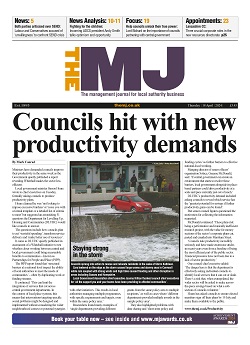There are 64 days until Christmas.
With a bit of basic subtraction, this means there are barely 40 days and nights until chancellor George Osborne delivers the now quite wintry Autumn Statement on 3 December.
This will be the penultimate opportunity for this most politic of chancellors to lay the groundwork for the General Election ahead of his final Budget.
So, expect bells and whistles, more gift-wrapping on the conference-pleasing tax giveaways and other pledges that could provide the clear blue water between the main opposition, coalition partners and UKIP upstarts alike.
And that’s before council finance officers can worry about when exactly before Christmas they can get the figures on the local government settlement to worry with over the New Year.
As a ruse to resolve how a future chancellor would balance the £25bn government spending cutbacks needed to maintain the current level of funding reductions, Mr Osborne’s last Autumn Statement introduced a method for reining in not just Departmental Expenditure Limits (DEL) but also Annual Managed Expenditure.
Whitehall wags have traditionally referred to this as ‘Annually Unmanaged Expenditure’, on the quite sensible basis that spending on pensions and welfare is as uncontrollable as a mob of rampaging Patagonians on the hunt for Jeremy Clarkson.
It will work like this.
Every Autumn Statement. the OBR will monitor compliance with the cap, which for 2015/16 has been set at £119.5bn out of total social security and tax credit spending of £218.8bn.
If it can be proven that Government policies have caused forecast spending to breach the cap, or if forecasting changes have pushed spending 2% above this, the chancellor would either have to take remedial action or secure parliamentary approval to increase the cap.
Mr Osborne gleefully sought to solve half this problem at Conservative Party Conference by pencilling in a further £12bn worth of Whitehall spending cutbacks over the first two years of the next Parliament.
In this context, his £3bn clawback from benefits paid to working age claimants should be seen as another piece of the puzzle.
So last week’s publication by independent forecasters to the Treasury, the Office of Budget Responsibility, of the inaugural welfare trends report, should be read with great interest.
But, the OBR’s report showed an increase in the numbers of renters and the higher cost of rents relative to wages pushed forecasts on housing benefit for 2015/16 and have revised upwards by 11% or £2.5bn in cash terms.
At a fundamental level, this puts in doubt the viability of the housing system, as Rachael Tiffen, CIPFA’s head of counter fraud has pointed out.
And, as the Institute for Fiscal Studies noted, a welfare cap in itself is not a guarantee of better policy-making that is well argued and well designed – given the propensity to achieving the quickest and most politically expedient cuts.
Want full article access?
Receive The MJ magazine each week and gain access to all the content on this website with a subscription.
Full website content includes additional, exclusive commentary and analysis on the issues affecting local government.
Already a subscriber? Login


